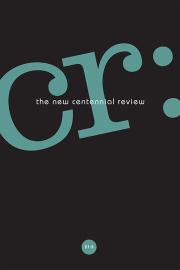“Your nostalgia is killing me!”
Or so the words in a 1993 image by the Canadian artist Vincent Chevalier shout in nauseating chartreuse, emphatically outlined in black (Visual AIDS n.d.). Driving the point home, these words appear in an image of a bedroom seen in simplified perspective on one side of a wall that forms a V-shaped triangle. Their color is all the queasier for appearing against a bright orange, red, and blue wallpaper that turns out, on closer inspection, to repeat, as wallpaper pattern, General Idea’s AIDS logo produced in the 1980s as art protest in the AIDS crisis. On that wall, images from the activist art collective Gran Fury appear as posters. The opposing wall of this bedroom has a black and white wallpaper of black squiggles on a white ground, made from the art of Keith Haring, a gay artist whose work was highly influential in disseminating awareness of the AIDS crisis in the 1980s. A photograph of activists with a QUEER NATION banner appears. The meaning of this garish domestic space is evident, if unsettling—the activist art associated with coalitions and groups such as ACT UP and QUEER NATION has become wallpaper and wallpaper art, domesticated in a crudely rendered domestic interior—not out on the streets, as these images may have been intended to circulate.
In calling this issue “AIDS Remains,” we want to contest lethal nostalgia. We want to insist that the AIDS crisis persists. We want to insist that AIDS insists. That we are doing so in the context of the global coronavirus pandemic makes our insistence even more urgent. Not, to be sure, because we believe that there are “lessons” to be learned from the AIDS crisis, and because we are proffering the AIDS crisis as some occasion relegated to the past from which it is possible to gain perspective. On the contrary, we are still in the thick of things. Nostalgia kills. Pretensions of distance and dispassion are more than misguided—they are dangerous.
--------------------------------------------------------------------------------------------------------------------------------------------------------
CR: The New Centennial Review is devoted to comparative studies of the Americas. The journal’s primary emphasis is on the opening up of the possibilities for a future Americas that does not amount to a mere reiteration of its past. We seek interventions, provocations, and, indeed, insurgencies that release futures for the Americas. In general, CR welcomes work that is inflected, informed, and driven by theoretical and philosophical concerns at the limits of the potentialities for the Americas.
The special section on “AIDS: Remains” was collected and edited by Richard Block, Professor of German Studies, University of Washington; Kathleen Chapman, Associate Professor, Department of Art History, Virginia Commonwealth University; and Mia Du Plessis, Associate Professor (of Teaching), Comparative Literature, University of Southern California.
Richard Block (bio), et al. "Introduction." CR: The New Centennial Review, vol. 21 no. 2, 2021, p. 1-4. Project MUSE muse.jhu.edu/article/846139.
Block, Richard. "Mourning Becomes Electric: The Disappearing Act of AIDS." CR: The New Centennial Review, vol. 21 no. 2, 2021, p. 55-82. Project MUSE muse.jhu.edu/article/846142.
Published by Michigan State University Press
